Barbarian kingdoms
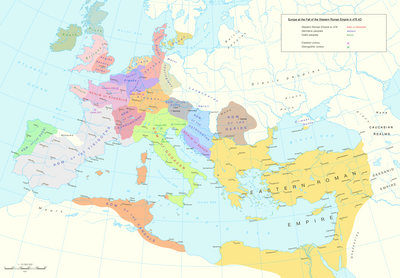
The barbarian kingdoms,[1][2][3] also referred to as the post-Roman kingdoms,[4] the western kingdoms,[2] or the early medieval kingdoms,[2] were states founded by various non-Roman, primarily Germanic, peoples in Western Europe and North Africa following the collapse of the Western Roman Empire in the fifth century.[1][2][3] The barbarian kingdoms were the principal governments in Western Europe in the Early Middle Ages. Their time is generally considered to have come to an end with Charlemagne's coronation as emperor in 800.[5]
The formation of the barbarian kingdoms was a complicated, gradual and largely unintentional process. Their origin can be traced to the Roman state failing to handle barbarian migrants on the imperial borders, which led to both invasions and invitations into imperial territory. Despite an increasing influx of barbarians, the Romans simultaneously denied them the ability to properly integrate into the imperial framework. Barbarian rulers were at first local warlords and client kings without firm connections to any territory. Their influence only increased as Roman emperors and usurpers began to use them as pawns in civil wars. The barbarian realms only transitioned into proper territorial kingdoms after the collapse of effective Western Roman central authority.
Barbarian kings established legitimacy through connecting themselves to the Roman Empire. Virtually all barbarian rulers assumed the style dominus noster ("our lord"), previously used by Roman emperors, and many assumed the praenomen Flavius, borne by nearly all Roman emperors in late antiquity. Most rulers also assumed a subordinate position in diplomacy with the remaining Eastern Roman Empire. Many aspects of the late Roman administration survived under barbarian rule, though the old system gradually dissolved and disappeared, a process accelerated by periods of political turmoil. Because the barbarian kingdoms were much smaller than the old empire, their administration was less complex and deep, which in turn led to a considerable breakdown in living standards as well as in social and economic complexity.
The barbarian kingdoms of Western Europe were for the most part fragile and ephemeral. By the time of Charlemagne's coronation in 800, only his Frankish Kingdom remained out of the once vast and diverse network of kingdoms.
Formation[edit]
Background (376–411)[edit]
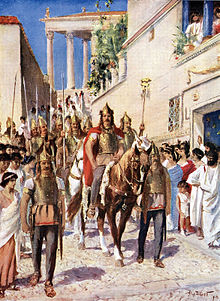
The rise of the barbarian kingdoms in the territory previously governed by the Western Roman Empire was a gradual, complex and largely unintentional process.[6] Their origin can ultimately be traced to the migrations of large numbers of barbarian (i.e. non-Roman) peoples into the territory of the Roman Empire. Although the Migration Period (c. 300–600) is often referred to as the "Barbarian Invasions", migrations were spurred not only by invasions but also by invitations. Inviting peoples from beyond the imperial frontier to settle Roman territory was not a new policy, and something that had been done several times by emperors in the past, mostly for economic, agricultural or military purposes. Because of the size and power of the Roman Empire, its capacity for immigration was nearly infinite.[6] Several events through the fourth and fifth centuries complicated the situation.[6]
In 376, the Visigoths were allowed to cross the Danube river and settle in the Balkans by the government of the Eastern Roman Empire.[7] The Visigoths, numbering perhaps 50,000 (out of which 10,000 were warriors),[8] were refugees, fleeing from the Ostrogoths, who in turn were fleeing from the Huns.[7] The Eastern emperor, Valens (r. 364–378), was pleased at the arrival of the Visigoths as it meant that he could recruit their warriors at low cost, bolstering his armies. Barbarian tribes seeking to settle in the empire were typically broken up into smaller groups and resettled across imperial territory. The Visigoths were however allowed to remain united and to themselves choose Thrace as their place of settlement.[9] Although the Roman state was to provide the Visigoths with food, imperial logistics could not handle the large number of refugees and Roman officials under the command of Lupicinus worsened the crisis by selling off much of the food before it reached the Visigoths. Amid rampant starvation, some Visigoth families were forced to sell their children into Roman slavery for food.[10] After Lipicinus had a group of high-ranking Visigoths killed, the situation erupted into a full-scale rebellion,[11] later known as the Gothic War (376–382). In 378, the Visigoths inflicted a crippling defeat on the Eastern Roman field army in the Battle of Adrianople, in which Emperor Valens was also killed.[7]
The defeat at Adrianople was a shock for the Romans, and forced them to negotiate with, and settle, the Visigoths within the imperial borders.[7] The treaties at the conclusion of the Gothic war made the Visigoths semi-independent foederati under their own leaders,[7] able to be called upon and drafted into the Roman army. Unlike previous settlements, the Visigoths were not dispersed and instead given cohesive lands in the provinces of Scythia, Moesia, and perhaps Macedonia.[12][13] Roman civil wars in the late 4th century, as well as periods of cold war between the imperial courts of the Western and Eastern Roman empires, allowed the Visigoths under their leader Alaric I (r. 395–410) to become an active force in imperial politics, only tenuously linked to the imperial government itself.[6] Both Visigoths and Romans were aware that Gothic autonomy had only been accepted because there were few alternatives and repeated Gothic casualties in Roman wars likely made the Visigoths increasingly suspicious of Roman motives.[14] In this context, the Visigoths revolted several times under Alaric, who sought to attain a formal position in the imperial framework as a Roman general, as well as pay for his followers as Roman soldiers.[15] Alaric was repeatedly caught in the rivalry and court intrigue between the Eastern and Western empires[16] and his failure to obtain formal recognition eventually led to his forces sacking Rome in 410.[17]
In addition to the Visigoths, numerous other barbarian groups began to migrate into imperial territory in the fifth century. Between 405 and 407, the Alans, Vandals, and Suebi migrated into Gaul in what is called the crossing of the Rhine.[6] The barbarians overwhelmed the Roman defensive works in the region[18] and led Roman forces in Britain to acclaim the usurper-emperor Constantine III (r. 407–411).[19] Constantine managed to effectively keep the barbarians on the Rhine in check and managed. The end of his reign due to further internal Roman conflict[20] left the armies in Gaul in tatters[21] and led to the tribes being able to penetrate deep into Gaul and Hispania.[20]
Imperial acceptance (411–476)[edit]
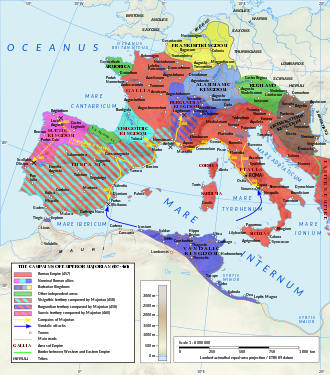
The second stage in the formation of the barbarian kingdoms was the imperial acceptance of the status quo. The Roman government at no point saw the existence of semi-autonomous barbarian-controlled territories as desirable, but began to tolerate them through the 420s and 430s.[6] Neither the Romans nor the various barbarian groups sought to establish new and lasting territorial kingdoms that replaced the imperial government. The rise of the barbarian kingdoms derived not from barbarian interest in creating them but from failures in Roman governance and a failure to integrate the barbarian rulers into the existing Roman imperial systems.[22]
Early barbarian rulers were tolerated only on the terms of the Roman Empire. Early 'kingdoms', such as those of the Suebi and Vandals in Hispania, were consequently relegated to the edges of less important provinces.[23] In 418, the Visigothic groups formerly under Alaric were settled by Emperor Honorius (r. 393–423) in Aquitania in southern Gaul, establishing the Visigothic Kingdom.[24][20] The Romans envisioned this as a provisional settlement of loyal clients of the imperial government, whose support could be relied on in internal struggles. The settlement was not seen as an actual ceding of imperial territory, given that the Roman administration was also envisioned as continuing in the granted lands, albeit overseen by the Visigoths as vassals.[20] Though some Roman generals in the time of Honorius had worked to curb the influence and power of the barbarian rulers, the number of civil wars that followed Honorius's death made the status of the barbarians a secondary concern. Instead of suppressing the barbarian kings, emperors and usurpers in the fifth century viewed them as useful internal players.[23]
The third stage of the formation of the barbarian kingdoms was the recognition by the imperial government of the increasingly unstable Western Roman Empire that it was no longer able to effectively administer its own territories. This led the empire to cede effective control of more lands to the barbarian rulers, whose realms now formed a permanent part of the landscape.[6] These territorial changes did not mean that lands within the former imperial borders ceased to be part of the Roman Empire on a conceptual level.[6] Treaties made with the Visigoths in 439 and the Vandals, who had conquered North Africa, in 442 effectively recognized the rulers of those peoples as territorial governors of parts of imperial territory, ceasing the pretension of active imperial administration. These treaties, though not seen as irrevocable, laid the foundations of true territorial kingdoms.[25]
Barbarian rulers took various steps to present themselves as legitimate rulers within the Roman imperial framework,[26] nominally subservient to the Western Roman emperor. This practice continued even after the deposition of the final western emperor, Romulus Augustulus, in 476. Barbarian rulers after 476 typically presented themselves as subservient to the remaining Eastern Roman emperor, and were in turn at times granted various honors by the imperial government.[27]
Emergence as territorial kingdoms (476–600)[edit]

Almost nowhere in Western Europe were barbarian rulers firmly linked to territorial kingdoms until the very late fifth century or even later.[28] The final stage in the formation of the barbarian kingdoms occurred as the barbarian rulers slowly lost the habit of waiting for the Western Roman Empire to again function properly. Left to their own devices, barbarian rulers instead began to take on the roles formerly held by the emperors, transitioning into proper territorial kings.[6] This process was only possible through the acceptance of barbarian rulers by local Roman aristocrats, who in many cases saw the possibility of restored Western Roman central control as an increasingly futile prospect.[29]
The exact process in which the barbarian kings took on certain functions and prerogatives previously ascribed to the Roman emperors is not entirely clear. It is believed to have been a highly drawn-out process.[30] History generally recognizes Alaric I as the first 'king of the Visigoths', though this title is applied to him only retroactively. Contemporary sources refer to Alaric only as dux or at times hegemon, and he did not rule a kingdom, instead spending his career unsuccessfully trying to integrate himself and his peple into the Roman imperial system. The earliest Visigothic ruler known to have called himself a king and to issue documents from something resembling an imperial chancery was Alaric II (r. 484–507),[31] though contemporary writings allude to widespread acceptance and recognition of a Visigothic kingdom in Gaul by the 450s.[31] The Visigoths did not establish a secure power-base as a consciously post-imperial kingdom until the 560s under Liuvigild, after slow and often brutal conquests in Hispania.[28]
The practice of the barbarian kingdoms being subservient to the Eastern Roman emperor came to an end as a result of the wars of reconquest of Emperor Justinian I (r. 527–565). Justinian sought to restore direct imperial control to the former western empire, though his reconquest was incomplete and established the idea that any lands outside of the estern empire's direct control was no longer part of the Roman world, also causing Roman identity to decline dramatically in Western Europe.[32] The coinage of the Visigothic Kingdom continued to depict the eastern emperors until the 580s, when the Visigothic kings began to mint coins in their own name.[33]
Roman heritage and continuity[edit]
Administrative continuity[edit]
The rise of the barbarian kingdoms saw power in Western Europe being dispersed from a single capital, such as Rome or Ravenna, to several local kings and warlords. Despite this, the apparatus of the former imperial government continued to fundamentally function in the west given that the barbarian rulers adopted many aspects of the late Roman administration.[1][4] Roman law remained the predominant legal system through the fifth and sixth centuries. Several barbarian kings showed interest in legal matters and issued their own law codes, developed based on Roman law.[34]
Towns and cities had been the main building blocks of the old empire and initially remained as such in the barbarian kingdoms as well. The disappearance of the old Roman imperial framework was a gradual and slow process, spanning centuries and at times accelerated due to political upheaval.[35]
The major difference between the Roman imperial administration and the new royal administrations that meant to imitate and replicate it was their scale. Without a central imperial court and officers that linked the governments of the different provinces together, the administrations in the kingdoms were flattened. Compared to the Roman Empire, the governments of the barbarian kingdoms were significantly less deep and complex.[30] This breakdown in Roman order had the side effect of resulting in a marked decline in living standards, as well as a marked collapse in economic and social complexity.[35]
Roman legitimacy[edit]

In the aftermath of the collapse of the Western Roman Empire, the barbarian rulers in Western Europe made an effort to strengthen legitimacy by adopting certain elements of the former empire. The title most widely used by the kings was rex, which formed a basis of authority which they could use in diplomacy with other kingdoms and the surviving imperial court in Constantinople.[36] Although some Eastern Roman authors, such as Procopius, described rex as a "barbarian term", it had at points in the past sometimes been used to describe Roman emperors and served to indicate that the barbarian rulers were sovereign rulers, though not with authority eclipsing that of the emperor in Constantinople.[26]
Many, but not all, of the barbarian kings used ethnic qualifiers in their title. The Frankish kings, for instance, rendered their title as rex Francorum ("king of the Franks"). The rulers of Italy, where the pretense of Roman continuity was especially strong, are notable in that they only rarely used ethnic qualifiers.[37]
In addition to rex, the barbarian rulers also assumed various Roman imperial titles and honours. Virtually all of the barbarian kings assumed the style dominus noster ("our lord"),[a] previously used only by Roman emperors, and nearly all of the Visigothic kings and the barbarian kings of Italy (up until the end of the Lombard kingdom) used the praenomen Flavius, borne by virtually all Roman emperors in late antiquity.[39] The early barbarian rulers were careful to maintain a subordinate position to the emperors in Constantinople, and were in turn sometimes recognised with various honours by the emperors,[40] in effect serving as highly autonomous client kings.[27]
Possibility of imperial restoration[edit]
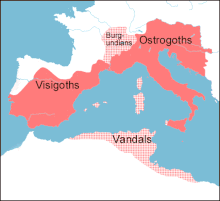
In the early sixth century, the most powerful kings in Western Europe were Theodoric the Great of Italy and Clovis I of the Franks. Both rulers received honours and recognition by the imperial court in Constantinople, which granted them a certain degree of legitimacy and was used to justify territorial expansion.[27] Theodoric was recognised as a patrician by Emperor Anastasius I, who also returned the western imperial regalia, in Constantinople since 476, to Italy.[40] These regalia were worn by Theoderic on occasions, and some of his Roman subjects referred to him as an emperor,[b] but he appears to himself only have used the title rex,[41] careful not to insult the emperor.[42] After the Franks defeated the Visigoths at the Battle of Vouillé in 507, Clovis was recognised by Anastasius as honorary consul, a patrician and a client king.[27] Like Theoderic, some of the subjects of Clovis also referred to him as an emperor, rather than king, though he never adopted that title himself.[43]
Theodoric and Clovis came close to war several times and it is conceivable that the victor of such a conflict would have re-established the Western Roman Empire under his own rule.[43] Though no war happened, such developments worried the Eastern Roman emperors. Worried that their granted honours could be seen as imperial "stamps of approval", the eastern court never granted them to the same extent again.[27] Instead, the eastern empire began to emphasise its own exclusive Roman legitimacy, which it would continue to do for the rest of its history.[43]
In the sixth century, Eastern Roman historians began to describe the west as "lost" to barbarian invasions, rather than the fact that many barbarian kings had been settled by the Romans themselves. This development has been termed the "Justinianic ideological offensive" by modern historians.[43] Though the rise of the barbarian kingdoms in the place of the western empire was far from an entirely peaceful process, the idea of "barbarian invasions" bringing a sudden and violent end to the world of antiquity, once also the widely accepted narrative among modern historians, does not accurately describe the period. Ascribing the end of the Western Roman Empire to "barbarian invasions" ignores the diversity of the new kingdoms in favor of a homogenous non-Roman barbarism and ignores any analysis in which the empire could be seen as complicit in its own collapse.[44]
Culture[edit]
Despite being divided into several smaller realms, the populace of the barbarian kingdoms maintained strong cultural and religious connections with each other, and continued to speak Latin.[1] The barbarian kings adopted both Christianity (at this point firmly established as the Roman religion) and the Latin language themselves, thus inheriting and maintaining Rome's cultural heritage. At the same time, they also remained connected to their non-Roman identity and made efforts to establish their own distinct identities.[4]
Roman identity gradually disappeared in Western Europe, both due to the Eastern Roman Empire emphasizing its own unique Roman legitimacy and due to the local barbarian ruling class and Roman populations merging ethnically.[32][45] The fading connectivity to the Roman Empire and the political division of the west led to a gradual fragmentation of culture and language, eventually giving rise to the modern Romance peoples and Romance languages.[46]
End of the barbarian kingdoms[edit]
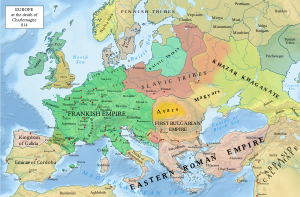
The barbarian kingdoms proved to be extremely fragile states.[47] Out of the three most powerful and long-lasting kingdoms—those of the Visigoths, Franks and Lombards—only the Frankish Kingdom survived the Early Middle Ages.[48]
The Visigothic Kingdom collapsed already in the sixth century and had to be restored almost from scratch by Liuvigild in the 560s and 570s. The kingdom was finally destroyed when it was conquered by the Umayyad Caliphate in the early 8th century.[47] In his wars of reconquest, the Eastern emperor Justinian I destroyed both the Vandal Kingdom in Africa and the Ostrogothic Kingdom in Italy.[47] Most of the smaller kingdoms in Gaul were conquered and absorbed into the Frankish Kingdom or disappear from historical sources entirely.[47]
In place of these kingdoms, new realms emerged in the seventh through ninth centuries that represented a new order, largely disconnected from the old Roman world. The Umayyad Caliphate, which conquered Hispania from the Visigoths and North Africa from the Eastern Roman Empire, made no pretences of Roman continuity. The Lombard Kingdom, though often counted among the other barbarian kingdoms, ruled an Italy destroyed by conflict between the Ostrogoths and the Eastern Roman Empire.[47] Their rule in Italy came to an end when their kingdom was conquered by the Franks in 774.[49] The small successor kingdoms of the Visigoths in Hispania—predecessors of medieval kingdoms such as León, Castile, and Aragon—were fundamentally sub-Frankish, culturally and administratively closer to the Frankish Kingdom than the fallen Visigothic Kingdom.[47]
As the sole survivor of the old kingdoms, the Frankish Kingdom provided the model of early medieval kingship that would later inspire Western European monarchs throughout the rest of the Middle Ages.[28] Though the Frankish rulers remembered Roman ideals and often aspired to vague ideas of imperial restoration, the centuries of their rule had transformed the governance of their kingdom into something that bore very little resemblance to the Roman Empire. The new form of government was a personal one, based on powers of, and relationships between, individuals, rather than the heavily administrated, judicial and bureaucratic system of the Romans.[47] The time of the barbarian kingdoms came to an end with the coronation of Charlemagne, king of the Franks, as Roman emperor by Pope Leo III in 800,[5] in opposition to the authority of the remaining Eastern Roman Empire.[50] Charlemagne's Carolingian Empire, a predecessor of France and Germany, was in reality more similar to a collection of kingdoms united only by Charlemagne's authority than a realm with a meaningful connection to the old Western Roman Empire.[51]
See also[edit]
Notes[edit]
- ^ Dominus noster continued to be used throughout Western Europe for centuries. For rulers of Italy, the style is recorded as late as under Desiderius (r. 756–774), the last Lombard king of Italy, whose coins style him as dominus noster Desiderius rex.[38]
- ^ For instance, an inscription by Caecina Mavortius Basilius Decius (western consul in 486, praetorian prefect of Italy 486–493) refers to Theoderic as dominus noster gloriosissimus adque inclytus rex Theodericus victor ac triumfator semper Augustus.[41]
References[edit]
- ^ a b c d Croke 2003, p. 349.
- ^ a b c d Kulikowski 2012, p. 31.
- ^ a b Delogu 2002, p. 84.
- ^ a b c Ghosh 2009, p. 1.
- ^ a b Bickmore 1857, Table III.
- ^ a b c d e f g h i Kulikowski 2012, p. 41.
- ^ a b c d e Katz 1955, pp. 88–89.
- ^ Heather 2005, pp. 145, 507.
- ^ Heather 2005, pp. 158–162.
- ^ Kulikowski 2006, p. 131.
- ^ Kulikowski 2006, pp. 133–134.
- ^ Heather 2005, pp. 185–186.
- ^ Kulikowski 2006, pp. 152–153.
- ^ Heather 1999, p. 50.
- ^ Heather 1999, p. 49.
- ^ Halsall 2007, p. 217.
- ^ James 2014, p. 57.
- ^ Heather 2005, p. 221.
- ^ Kulikowski 2000, pp. 328, 332–334.
- ^ a b c d Kulikowski 2012, p. 42.
- ^ Heather 2008, pp. 247, 513.
- ^ Kulikowski 2012, p. 33.
- ^ a b Kulikowski 2012, p. 43.
- ^ Kulikowski 2006, p. 158.
- ^ Kulikowski 2012, p. 45.
- ^ a b Gillett 2002, pp. 118–119.
- ^ a b c d e Mathisen 2012, pp. 105–107.
- ^ a b c Kulikowski 2012, p. 40.
- ^ Kulikowski 2012, p. 47.
- ^ a b Kulikowski 2012, p. 48.
- ^ a b Kulikowski 2012, p. 36.
- ^ a b Halsall 2018, p. 53.
- ^ Grierson & Blackburn 1986, pp. 49–52.
- ^ Kulikowski 2012, p. 49.
- ^ a b Kulikowski 2012, p. 32.
- ^ Halsall 2018, p. 51.
- ^ Gillett 2002, pp. 113–114.
- ^ Gillett 2002, pp. 91–105.
- ^ Gillett 2002, p. 116.
- ^ a b Bury 2005, pp. 422–424.
- ^ a b Jones 1962, p. 128.
- ^ Hen 2018, p. 66.
- ^ a b c d Halsall 2018, p. 52.
- ^ Kulikowski 2012, pp. 31–32.
- ^ Parker 2018, pp. 7, 10.
- ^ Pohl 2018, pp. 4, 15–18, 38–39.
- ^ a b c d e f g Kulikowski 2012, p. 50.
- ^ Kulikowski 2012, pp. 32, 34.
- ^ Muldoon 1999, p. 47.
- ^ Nelsen & Guth 2003, p. 5.
- ^ Delogu 2002.
Bibliography[edit]
- Bickmore, W. E. (1857). Four Tables of Comparative Chronology, Illustrating the Division of Universal History Into Ancient History, Middle Ages, and Modern History: And Containing a System of Combinations, Distinguished by a Particular Type, to Assist the Memory in Retaining Dates. Bell and Daldy.
- Bury, John Bagnell (2005). A History of the Later Roman Empire from Arcadius to Irene (395 A.D. to 800 A.D.). Adamant Media Corp. ISBN 978-1-4021-8368-3.
- Croke, Brian (2003). "Latin Historiography and the Barbarian Kingdoms". Greek and Roman Historiography in Late Antiquity: Fourth to Sixth Century A.D. Leiden: Brill. ISBN 90-04-11275-8.
- Delogu, Paolo (2002). Introduction to Medieval History. Bristol: Bristol Classical Press. ISBN 978-0715630792.
- Ghosh, Shami (2009). The Barbarian Past in Early Medieval Historical Narrative (PDF) (Doctoral thesis). University of Toronto.
- Gillett, Andrew (2002). "Was Ethnicity Politicized in the Earliest Medieval Kingdoms?". On Barbarian Identity: Critical Approaches to Ethnicity in the Early Middle Ages. Studies in the Early Middle Ages. Brepols Publishers. ISBN 978-2-503-53872-3.
- Grierson, Philip; Blackburn, Mark (1986). Medieval European Coinage: Volume 1, The Early Middle Ages (5th-10th Centuries). Cambridge University Press. ISBN 978-0-521-03177-6.
- Halsall, Guy (2007). Barbarian Migrations and the Roman West, 376–568. Cambridge and New York: Cambridge University Press. ISBN 978-0-52143-543-7.
- Halsall, Guy (2018). "Transformations of Romanness: The northern Gallic case". In Pohl, Walter; Gantner, Clemens; Grifoni, Cinzia; Pollheimer-Mohaupt, Marianne (eds.). Transformations of Romanness: Early Medieval Regions and Identities. De Gruyter. ISBN 978-3-11-059838-4.
- Heather, P. (1999). "The Creation of the Visigoths". The Visigoths: From the Migration Period to the Seventh Century. The Boydell Press. ISBN 0-85115-762-9.
- Heather, P. (2005). The Fall of the Roman Empire. ISBN 978-0-19-515954-7.
- Heather, Peter (2008) [1998]. "Goths and Huns, c. 320–425". In Cameron, Averil; Garnsey, Peter (eds.). The Cambridge Ancient History: The Late Empire, A.D. 337–425. Vol. XIII. Cambridge: Cambridge University Press. pp. 487–515. ISBN 978-0-5213-0200-5.
- Hen, Yitzhak (2018). "Compelling and intense: the Christian transformation of Romanness". In Pohl, Walter; Gantner, Clemens; Grifoni, Cinzia; Pollheimer-Mohaupt, Marianne (eds.). Transformations of Romanness: Early Medieval Regions and Identities. De Gruyter. ISBN 978-3-11-059838-4.
- James, Edward (2014). Europe's Barbarians, AD 200–600. London and New York: Routledge. ISBN 978-0-58277-296-0.
- Jones, A. H. M. (1962). "The Constitutional Position of Odoacer and Theoderic" (PDF). The Journal of Roman Studies. 52 (1–2): 126–130. doi:10.2307/297883. JSTOR 297883. S2CID 163824464.
- Katz, Solomon (1955). The Decline of Rome and the Rise of Mediaeval Europe. Ithaca, NY: Cornell University Press. ASIN B002S62FYI.
- Kulikowski, Michael (2000). "Barbarians in Gaul, Usurpers in Britain". Britannia. 31: 325–334. doi:10.2307/526925. JSTOR 526925. S2CID 162663612.
- Kulikowski, M. (2006). Rome's Gothic Wars. ISBN 978-0-521-8-4633-2.
- Kulikowski, Michael (2012). "The Western Kingdoms". In Fitzgerald Johnson, Scott (ed.). The Oxford Handbook of Late Antiquity. Oxford: Oxford University Press. ISBN 978-0195336931.
- Mathisen, Ralph W. (2012). "Clovis, Anastasius, and Political Status in 508 C.E.: The Frankish Aftermath of the Battle of Vouillé". In Mathisen, Ralph W.; Shanzer, Danuta (eds.). The Battle of Vouillé, 507 CE: Where France Began. De Gruyter. pp. 79–110. doi:10.1515/9781614510994.79. ISBN 978-1-61451-099-4.
- Mathisen, Ralph W. (2015). "Barbarian Immigration and Integration in the Late Roman Empire: The Case of Barbarian Citizenship". In Sänger, Patrick (ed.). Minderheiten und Migration in der griechisch-römischen Welt. BRILL. ISBN 978-3-506-76635-9.
- Muldoon, James (1999). Empire and Order: The Concept of Empire, 800–1800. Springer. ISBN 978-0312222260.
- Nelsen, Brent F.; Guth, James L. (2003). "Roman Catholicism and the Founding of Europe: How Catholics Shaped the European Communities". The American Political Science Association.
- Parker, Eugene Johan Janssen (2018). Vandalia: Identity, Policy, and Nation-Building in Late-Antique North Africa (Master's thesis). Victoria University of Wellington.
- Pohl, Walter (2014). "Romanness: a multiple identity and its changes". Early Medieval Europe. 22 (4): 406–418. doi:10.1111/emed.12078. S2CID 154201199.
- Pohl, Walter (2018). "Introduction: Early medieval Romanness - a multiple identity". In Pohl, Walter; Gantner, Clemens; Grifoni, Cinzia; Pollheimer-Mohaupt, Marianne (eds.). Transformations of Romanness: Early Medieval Regions and Identities. De Gruyter. ISBN 978-3-11-059838-4.
